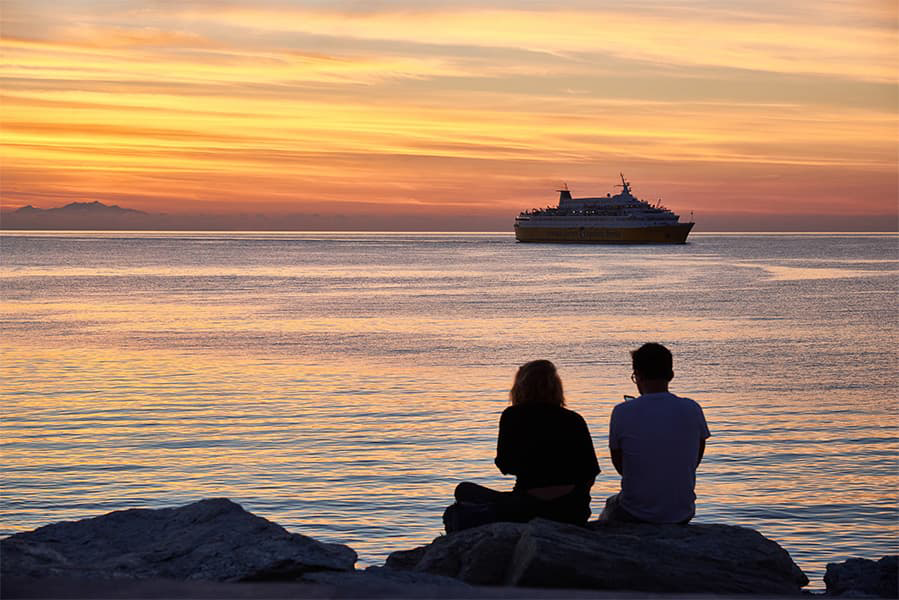Valletta – Catania
Ferries to Sicily
Valletta – Catania
Ferries to Sicily

There are around 4 weekly sailings from Valletta to Catania. The Valletta Catania ferry is operated by
Ferries from Valletta to Catania typically depart from Valletta at around 05:00. The average sailing time of a Catania Valletta ferry is approximately 4h 15m.
Ferry prices for Valletta Catania ferries typically range between €103* and €374*. The average price is around €232*. The cheapest ferry prices from Valletta to Catania start from €81*. The average price for a foot passenger is €232*.
Pricing will vary by season and depend on the number of passengers, vehicle type and sailing time.
The distance between Valletta to Catania is approximately 115.3 miles (185.6km), or 100.2 nautical miles.
No ferry operators currently provide a car ferry between Valletta and Catania
Yes, foot passengers can travel on ferries from Valletta to Catania with Virtu Ferries.
More routes than anyone else.

Compare fares, times & routes in one place.
Change plans easily with flexi tickets.

Book e-tickets & manage trips in-app.
Live ship tracking & real-time updates.

Top-rated customer support when you need it.
| Valletta - Catania Route summary | ||
|---|---|---|
| Departure Country | Malta | |
| Destination Country | Italy | |
| No. of Operators | 1 | |
| Operators | Virtu Ferries | |
| Average Price | 294 €* | |
| Average Weekly Sailings | 4 | |
| Average Sailing Duration | 4h 15m | |
| First Ferry | 05:00 | |
| Last Ferry | 18:00 | |
| Distance | 100 nautical miles | |
* Prices subject to change, pricing is taken from last 30 days, last updated 2024-07-02.
Valletta is the capital of Malta and lies in the central eastern part of the island and the Valletta Peninsular is home to two natural harbours; Marsamxett and the Grand Harbour, which is Malta's main port that has a number of quays at Marsa. Along the old sea wall of Valletta's waterfront, which was built by Manuel Pinto de Fonseca, there now stands a cruise liner terminal. Many of the city's buildings date back to the 16th century and were built during the reign of the Order of St. John of Jerusalem, also known as the Knights Hospitaller. The mainly Baroque city also has traces of Mannerist, Neo-classical and modern architecture and the effects of the Second World War on the city are clear to see with many scars left behind - particularly the demolition of The Royal Opera House. In 1980 Valletta was declared a UNESCO World Heritage Site and is the island's cultural centre with many churches, palaces and museums for tourists to explore.
Ferry services operating from the port depart to Catania and Pozzallo.
Catania is located on the east coast of Sicily on the Ionian Sea and is the second largest city in Sicily and sits under the imposing shadow of Mount Etna, or A Muntagna as the locals call it. The volcano has had a significant influence on the city's history and its actual existence, having destroyed the city on several occasions. The most destructive being an eruption in the 17th century. Catania was covered in lava in 1669 and then 24 years later, in 1693, an earthquake shook the town to its foundations.
A popular attraction in the city, located on the edge of the town's square is the Cathedral which is dedicated to St. Agata, the city's patron saint. The cathedral stands on the site of an earlier 11th century church that was almost entirely destroyed in the 1693 earthquake. The imposing cathedral's baroque architectural style incorporates Roman columns taken from an amphitheatre. There are more Roman elements in the cathedral as beneath there are some Roman baths. The Baroque theme continues within the cathedral's interior with several ornate chapels and a fresco depicting the 1693 earthquake. Catania's most famous son, Bellini, is buried in the cathedral as are three Aragonese Kings: Frederick II, Louis and Frederick III.